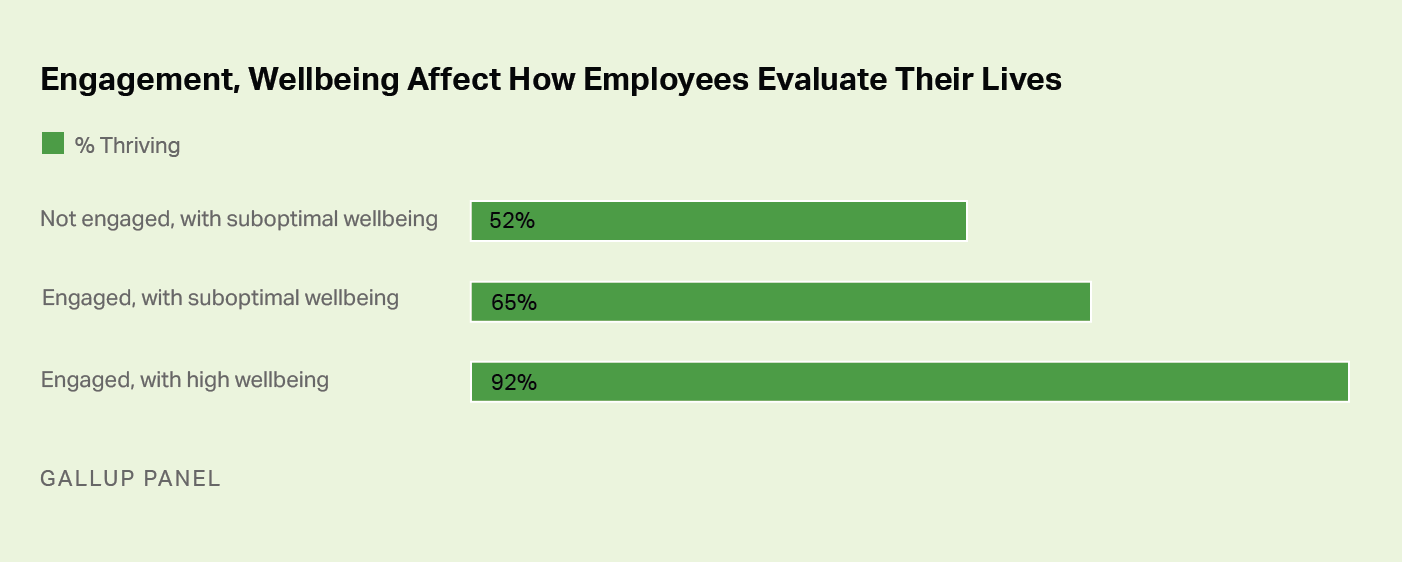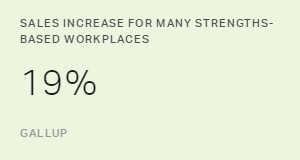Story Highlights
- Employee engagement and wellbeing yield additive benefits
- Engaged and high-wellbeing workers have higher life ratings
- Best practices incorporate wellbeing into engagement action planning
Employee engagement has long been recognized as an important driver of employee retention and performance. And wellbeing -- most often manifested as a wellness program -- has been adopted by some organizations to drive down healthcare costs.
And yet Gallup has found a striking relationship between engagement and wellbeing, with major consequences for employee productivity and performance:
Engagement and wellbeing are highly reciprocal, with each influencing the future state of the other to a similar degree.
But they are also additive -- high wellbeing enhances the benefits of engagement, lifting employee performance to levels not reached through engagement alone.
It is critical for wellbeing to be conceptualized and addressed holistically across all five of its essential elements -- career, social, financial, community and physical. Physical wellness programs alone are not enough to support a thriving, high-performing workforce.
Additionally, maximizing the use of employees' natural strengths -- a vital component of both engagement and wellbeing and one that is deeply intertwined with each -- has also been shown to boost employee performance when both engagement and wellbeing are high. Workplace burnout is reduced to near zero among engaged, high-wellbeing employees who also work in a culture that honors individual strengths.
Employee performance has always been vital to business outcomes, both pre-COVID and amid the COVID-19 pandemic. And to maximize employee performance, leaders should care how well their employees' psychological needs are being met and how they are evaluating and experiencing their lives, whether at work or at home.
Engagement, Wellbeing Greatly Influence How We Evaluate Our Lives
The pandemic has had an extraordinarily negative impact on wellbeing among U.S. adults, with overall life evaluation, daily stress and daily worry worsening in unprecedented ways.
In the case of life ratings, for example, Gallup classifies respondents as "thriving," "struggling" or "suffering" according to how they rate their current and future lives on a ladder scale with steps numbered from zero to 10, based on the Cantril Self-Anchoring Striving Scale.
Those who rate their current life as a "7" or higher and their anticipated life in five years as an "8" or higher are classified as thriving. In March and April, the percentage of U.S. adults who were thriving plummeted nearly 10 percentage points to 46.4%, matching the previous historic low last measured in November 2008 amid the Great Recession.
But employee engagement and wellbeing can greatly insulate workers from the pandemic's potentially damaging effects on life ratings.
Workplace burnout is reduced to near zero among engaged, high-wellbeing employees who also work in a culture that honors individual strengths.
Nationally, about two-thirds of workers (66%) are not engaged and have suboptimal wellbeing. Of these, 52% are considered thriving in their overall life evaluation.
Another 22% of workers, in turn, are engaged at work but have suboptimal wellbeing. Of these, 65% are thriving, a notable boost.
But when engagement and high wellbeing are both present, the impact on life evaluations is palpable. For these workers -- about 12% of the U.S. working population -- 92% are considered to be thriving.

Bar chart. Among U.S. employees who are not engaged and who have suboptimal wellbeing, 52% are engaged. Those who are engaged but have suboptimal wellbeing have a thriving rate of 65%. And workers who are both engaged and have high wellbeing have a thriving rate of 92%.
10 Ways to Build a Resilient, High-Performing Workforce
Given the clear returns on investment for building workers who are both engaged and have high holistic wellbeing, leaders can make a substantial difference in their employees' performance and lives by including wellbeing principles in engagement programs and making the most of their reciprocal, additive effects.
Here are 10 actions leaders can take to increase employee engagement and wellbeing and improve business outcomes -- all at the same time.
1. Include employees in the wellbeing conversation.
Asking employees to contribute wellbeing ideas is a great way to galvanize the workforce and make them feel like they are part of the wellbeing movement. Solicit ideas on how to enhance career, social, financial, community and physical wellbeing both at work and at home. Make sure all ideas are discussed openly, and search for ways to incorporate them into workplace programs and offerings. Not only can they provide insights on new programs, but they also can help improve current ones. As the people using (or choosing not to use) what's currently available to them, they will have useful feedback about what's working and where there's room to improve.
If ideas are ultimately not used, be transparent as to why to avoid discouraging future input and participation. The more employees contribute to the wellbeing efforts of the organization, the more they will feel their opinions count and the greater their buy-in and likelihood to participate will be.
Employee engagement dimensions addressed:
At work, my opinions seem to count.
I have the materials and equipment I need to do my work right.
2. Link the wellbeing of each employee to the successful mission or purpose of the organization.
Feeling that one's organization has an important mission or purpose is a critical aspect of engagement. To this end, have employees review the mission of their organization and discuss how a vibrant wellbeing culture for each element is critical to the mission's success. Conversely, how might the mission help them lead a life well-lived? Find ways to create reminders of these connections, whether it's creating posters explaining how each element of wellbeing is connected to the mission or hosting on-site or virtual opportunities to live out the mission and culture of wellbeing.
Defining wellbeing in the context of mission and purpose makes it actionable and demonstrates that it's a part of your organization's culture, not just the latest buzzword.
Employee engagement dimension addressed:
The mission or purpose of my company makes me feel my job is important.
3. Strongly encourage participation in wellbeing activities when setting job expectations and goals.
Let employees choose the wellbeing activities best suited to them based on their individual wellbeing goals, thus engendering individual accountability and ownership. In so doing, this approach simultaneously promotes clarity about an employee's role and a culture of wellbeing, and it does so while honoring each person's unique talents and interests. And remember that employees are often unaware of the programs and offerings that are out there -- this is a great time to clarify what they have at their disposal.
Employee engagement dimensions addressed:
I know what is expected of me at work.
At work, I have the opportunity to do what I do best every day.
4. Have each employee identify the element of wellbeing they feel comes naturally to them and at which they are most successful.
One of the manager's most important roles is focusing on the natural strengths of employees, with strengths-based management practices yielding a wide array of positive business outcomes. To draw this out in the context of building wellbeing, have employees in one-on-one or small-group meetings describe the element of wellbeing that they gravitate to most easily. Learn about what factors in life and work motivate them to succeed and how they succeed, providing examples for others while simultaneously honoring what they are best at in their lives and in the workplace.
Employee engagement dimension addressed:
At work, I have the opportunity to do what I do best every day.
5. Recognize employees for their wellbeing achievements.
Recognition reinforces what is valued within an organizational culture. One reason recognition is such a reliable driver of employee engagement is that if employees feel they will be recognized for doing great work, they will be highly motivated. The same principle applies when enhancing wellbeing. Formalize mechanisms in the workplace for providing recognition of wellbeing accomplishments to increase both visibility and effort, thus improving wellbeing and engagement at the same time. And don't forget that it's not just about physical wellness -- be sure to create a recognition mechanism for each element.
Employee engagement dimension addressed:
In the last seven days, I have received recognition or praise for doing good work.
6. Follow up to show you care.
Have employees submit their interests and goals for wellbeing to their managers and actively monitor what they are pursuing. Refresh your memory in advance of formal progress meetings and social events so that wellbeing can be easily raised in conversation. Ask them how they are progressing toward their goals so that when appropriate, you can share their insights with others. And always be sure to inquire about the wellbeing of family members and brainstorm how to include them in workplace wellbeing activities, a critical driver of improvement over time in employees' wellbeing.
This feedback mechanism will significantly enhance how much employees feel cared about -- a foundational aspect of engagement -- while simultaneously reinforcing a culture of wellbeing.
Employee engagement dimensions addressed:
My supervisor, or someone at work, seems to care about me as a person.
I have a best friend at work.
In the last six months, someone at work has talked to me about my progress.
7. Create a 'Wellbeing Board of Directors.'
Have employees identify at least three people at work who have had the most significant impact on their wellbeing, and why each has created a significant impact. Then have each person write a note to each member of their board describing why they are on the list. Doing so serves as a great recognition mechanism for the board members while also informally cultivating a wellbeing mentoring apparatus in the workplace, which is a core aspect of having someone who "encourages your development."
Employee engagement dimensions addressed:
In the last seven days, I have received recognition or praise for doing good work.
There is someone at work who encourages my development.
8. Create a sharing network to socialize best practices.
Whether meeting about work or meeting for fun, pre-assign individuals to different tables, groups or teams. Allow time for each person to say something about their personal wellbeing that is important to them but that they think others might not know. Include important tips, such as useful apps or books that have been read. This can create a wellbeing social network where it did not exist before and provide the opportunity for new thinking regarding pursuing a life well-lived. Not getting together in person due to COVID? No problem -- the same approach can be applied using online meeting apps.
Employee engagement dimensions addressed:
This last year, I have had opportunities at work to learn and grow.
I have a best friend at work.
9. Explicitly link each workplace wellbeing activity to at least one of the five elements.
The five elements can help managers more clearly individualize activities to each employee's situation through discussion and by creating a more focused set of goals. Leaders and managers should communicate that the five elements are important organizational values. Communication that emphasizes how leadership cares about employees' wellbeing -- and the wellbeing of employees' families -- can go a long way in encouraging engagement and participation in wellbeing programs.
Employee engagement dimensions addressed:
This last year, I have had opportunities at work to learn and grow.
In the last six months, someone at work has talked to me about my progress.
My supervisor, or someone at work, seems to care about me as a person.
The mission or purpose of my organization makes me feel my job is important.
10. Include wellbeing goal setting and milestones in work reviews and progress meetings.
Research has shown that engaged employees are much more comfortable discussing their wellbeing goals with their manager. But the five elements of wellbeing can be incorporated into progress review conversations in ways that encourage all employees to pursue their wellbeing goals and deepen the manager-employee relationship. One way to start this conversation is for managers to ask, "Is there an aspect of your wellbeing that I can support?" And don't forget the critical nature of routine, ongoing dialogue that occurs in between more formal feedback sessions. The more wellbeing is discussed on an ongoing basis, the more it will be embedded in the culture of the organization.
Employee engagement dimensions addressed:
This last year, I have had opportunities at work to learn and grow.
In the last six months, someone at work has talked to me about my progress.
My supervisor, or someone at work, seems to care about me as a person.
The Bottom Line
Now more than ever, companies need to inspire the best in their workforce. By adopting a best-practice approach of addressing employee engagement and employee wellbeing at the same time and taking practical actions even when budgets are tight, workers will be more likely to have their critical psychological needs met, stay engaged and be insulated from the negative effects of the extraordinary amounts of stress they are experiencing. In this way, leaders of organizations can play a critical -- and potentially decisive -- role in maximizing a job well done and a life well-lived.
Gallup can help you get started:
- Download the highlights from Gallup's meta-analysis on the relationship between employee engagement and performance.
- Discover how to identify burned out employees and prevent further burnout in your organization.




